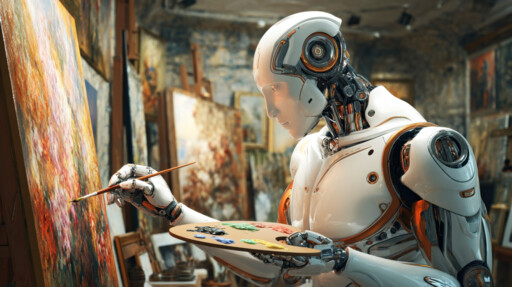


AI art transforming art theory and creative practice

In recent years, AI has made remarkable progress in artistic creation, and AI-generated art has become a prominent example of the integration of art and technology. Photo: TUCHONG
In recent years, artificial intelligence has made remarkable progress in artistic creation. For instance, Théatre D’opéra Spatial, a digital art piece produced by the AI image generator Midjourney, won first place in the digital art category at the 2022 Colorado State Fair’s annual fine art competition. Edmond de Belamy, a portrait created using a generative adversarial network (GAN), was sold for $432,500 at a Christie’s auction in 2018. A.I. God, a portrait of Alan Turing by a humanoid artist robot Ai-Da, fetched $1,084,800 at a Sotheby’s auction in 2024. Also released in 2024, the video-generation model Sora has garnered wide attention in the art world for its strikingly lifelike creations. AI art has thus become a prominent example of the integration of art and technology, marking the latest stage in the evolution of tech-based art.
AI art driving a renewal of art theory
Theoretical research on AI art in Chinese academia exhibits the following characteristics. First, it spans a wide range of artistic forms, covering nearly all traditional domains including literature, painting, design, music, dance, film, and television. Second, scholars are actively promoting in-depth dialogue between AI art and traditional art theories, including those centered on imitation, expression, creation, emotion, narration, and form. The novel attributes of AI art both enrich and challenge these existing theoretical traditions. Third, the role of AI in artistic creation is a subject of heated debate: Should AI be recognized as a creative agent in its own right, or merely as a tool? Closely tied to this is the pressing issue of intellectual property rights in AI-generated art. Fourth, evaluations of AI art vary: some critiques highlight its creative potential, while others emphasize its limitations. Fifth, the study and creation of AI art are becoming increasingly intertwined, with theory and practice enhancing and inspiring one another.
Currently, two main paradigms dominate research on AI art: the aesthetic-artistic paradigm and the legal paradigm. The former focuses on theoretical questions such as the aesthetic properties of AI art, while the latter addresses practical concerns like intellectual property ownership. Both are fundamentally concerned with whether AI should be regarded as an autonomous agent or a mere instrument. Meanwhile, new paradigms are also emerging. Because AI art often involves co-creation, the sociological paradigm examines its production, distribution, and consumption through the lens of collective activity. The psychological paradigm, for its part, draws on neuroaesthetics to explore the mechanisms of creativity and the audience’s reception of AI art.
Growing importance of human experience
At present, AI is not recognized as an autonomous agent of artistic creation; rather, it functions as a tool for human artistic production. This has given rise to a new model of creativity characterized as “AI generation + human selection.” For example, Professor Wang Feng and his team from the School of Communication at East China Normal University created an AI-generated novel Apostle of Destiny using a combination of “Chinese large language models + prompt engineering + human post-editing.” What skills, then, should human artists master in order to harness AI technology effectively□
First, strong language skills are essential. In text-to-image generation, language-based prompts are indispensable. A thorough understanding of the interplay between language and image is necessary to discern how subtle changes in wording correspond to variations in the generated images. In text-to-video generation, strong narrative skills are key to producing excellent AI films. Second, artistic sensibility remains crucial. While AI is capable of generating a large number of works within a brief timeframe, human creators must screen their output according to certain aesthetic standards. Therefore, producing high-quality AI-assisted artwork requires human creators to excel in artistic creation, art appreciation, and art criticism. These competencies may themselves take on new dimensions that warrant further scholarly inquiry.
The role of humans as selectors does not diminish the significance of human experience—on the contrary, it heightens it. The spiritual essence of AI art is conferred by the audience and is activated through their experience. While humans can both use AI in artistic creation and appreciate the generated works, they should not abandon their own creativity, as deeper fulfillment arises from active creation. Human creation, deeply rooted in lived experience, should never be reduced to a purely formalistic exercise.
As AI art rises to prominence, humans should, on one hand, leverage AI to enhance their own creative capabilities and actively explore new models and theories of human-AI co-creation. On the other hand, they should use AI as a mirror to reflect on the fundamental characteristics and advantages of human creativity, fully realizing the theoretical potential of related research.
Lu Wenchao is a professor from the School of Art at Southeast University.
Editor:Yu Hui
Copyright©2023 CSSN All Rights Reserved